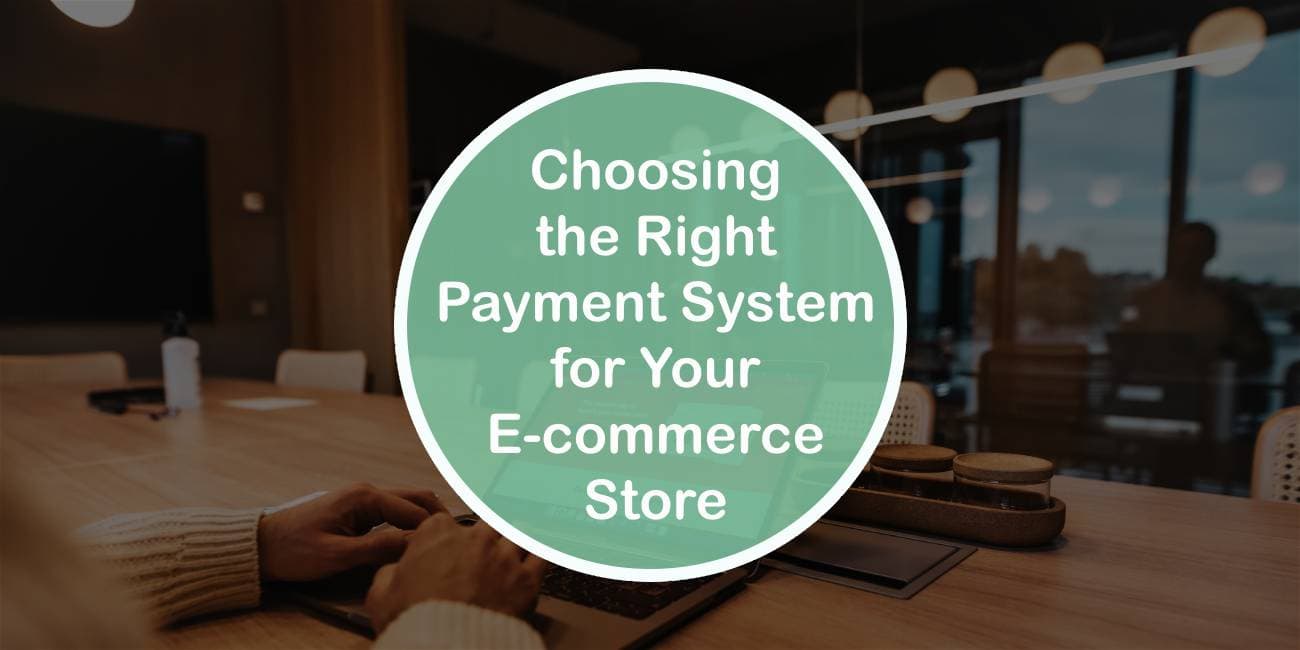In the digital age, where online shopping has become the norm rather than the exception, choosing the right payment system for your e-commerce store is a crucial decision that can make or break your business. Imagine this: a customer visits your beautifully designed website, fills their virtual cart with products they love, only to abandon it at checkout due to a complicated or unreliable payment process. The convenience and security of your chosen payment system can directly impact not only sales but also customer trust and loyalty. In this article, we will delve into the world of e-commerce payment systems, exploring the diverse options available and providing you with essential insights to help you make an informed choice that aligns perfectly with your business goals and customer needs. So buckle up as we navigate through the intricate landscape of online payments and discover how selecting the right system can propel your e-commerce venture towards success in today’s competitive marketplace.
Understanding Payment System Types
When it comes to e-commerce payments, understanding the different types of payment systems is crucial for success. One common type is the traditional credit card payment system, which provides a convenient and familiar way for customers to purchase goods online. However, emerging trends like digital wallets are gaining popularity due to their security features and ease of use. These virtual payment systems allow customers to make transactions without sharing sensitive financial information, boosting trust and reducing fraud risks for both merchants and consumers.
Another innovative payment system is Buy Now Pay Later (BNPL), offering flexibility by allowing shoppers to split their purchases into interest-free installments. This option can attract budget-conscious consumers who prefer spreading out payments over time rather than making a one-time transaction. Understanding the various payment system types available can help e-commerce businesses cater to diverse customer preferences, ultimately leading to increased sales and customer satisfaction in today’s competitive market landscape.
Factors to Consider When Choosing
When choosing the right payment system for your e-commerce store, it is crucial to consider the user experience. The payment process should be seamless, secure, and intuitive for customers to complete transactions without any hurdles. Additionally, integrating multiple payment options can cater to a wider audience with varying preferences.
Consider the fees associated with different payment systems as they can impact your profit margins. Some providers may charge higher processing fees or additional transaction costs that could eat into your revenue. It’s essential to compare these charges and find a balance between cost-efficiency and service quality when selecting a payment solution for your online store. For instance, businesses selling niche products like vapes may benefit from systems that support international payments to reach a global customer base effectively.

Security and Fraud Prevention Measures
When it comes to running an e-commerce store, security and fraud prevention measures are paramount in safeguarding both your business and your customers’ sensitive information. Implementing multi-layer security protocols such as SSL encryption, two-factor authentication, and PCI compliance can help create a secure environment for transactions. Regularly monitoring transaction patterns and using fraud detection tools can aid in identifying any suspicious activities early on.
In addition to proactive security measures, educating both your team and customers on common fraud tactics and how to spot them is crucial. Building trust with customers through transparent communication about your security practices can also help in reducing concerns around fraud. Remember, investing in robust security measures not only protects your business from potential financial losses but also helps build a strong reputation for reliability within the e-commerce industry.
Integration with E-commerce Platforms
Integrating with popular e-commerce platforms is crucial for ensuring a seamless and efficient payment process for online stores. By integrating directly with platforms like Shopify, WooCommerce, or Magento, businesses can streamline their checkout process, offering customers a convenient and hassle-free experience. This integration allows for real-time data synchronization, inventory management, and order tracking.
Furthermore, integrating with e-commerce platforms opens up opportunities for businesses to expand their reach and tap into new markets. With the rising trend of omnichannel retailing, having a payment system that seamlessly integrates across various channels can be a game-changer. It not only enhances customer satisfaction but also helps in gaining valuable insights into buyer behavior and preferences. In today’s competitive landscape, connecting your payment system with e-commerce platforms is no longer just beneficial; it’s essential for staying ahead of the curve in the digital marketplace.

Fees and Transaction Costs Comparison
When it comes to fees and transaction costs, choosing the right payment system for your e-commerce store can make a significant impact on your bottom line. Different payment gateways have varying fee structures that can affect your profit margins. Some gateways charge a percentage of each transaction, while others have fixed fees per transaction. It’s crucial to carefully compare these costs to determine which option aligns best with your business model.
Moreover, hidden fees and additional charges can quickly add up and eat into your profits. Be sure to read the fine print and understand all the potential costs associated with each payment system before making a decision. Consider factors such as chargeback fees, currency conversion fees, monthly subscription charges, and any other miscellaneous expenses that may apply. By conducting a thorough analysis of the total cost of using each payment gateway, you can make an informed choice that benefits both your customers and your business in the long run.
Customer Experience and User-Friendliness
When it comes to running an e-commerce store, customer experience and user-friendliness are paramount. Your payment system can make or break the shopping experience for your customers. A seamless and intuitive payment process will not only boost conversion rates but also foster trust and loyalty among shoppers.
User-friendly payment systems simplify the checkout process, reducing the likelihood of cart abandonment. Offering multiple payment options caters to a diverse range of customers, enhancing their overall shopping experience. By prioritizing customer experience and user-friendliness in your choice of payment system, you can differentiate your store from competitors and create a lasting impression on shoppers.

Conclusion: Selecting the best payment system option
In conclusion, selecting the best payment system option for your e-commerce store is a crucial decision that can greatly impact your business’s success. By considering factors such as customer preferences, security features, and transaction fees, you can choose a payment system that aligns with your unique needs and goals. It’s important to keep in mind that offering multiple payment options can enhance customer satisfaction and increase conversion rates.
Additionally, staying informed about the latest trends in payment technology can help you stay competitive in the ever-evolving e-commerce landscape. Exploring emerging options like digital wallets and buy now, pay later services could give your store a competitive edge and cater to evolving consumer behaviors. Ultimately, continuously evaluating and optimizing your chosen payment system will be essential to providing a seamless shopping experience for customers while maximizing revenue for your business.

